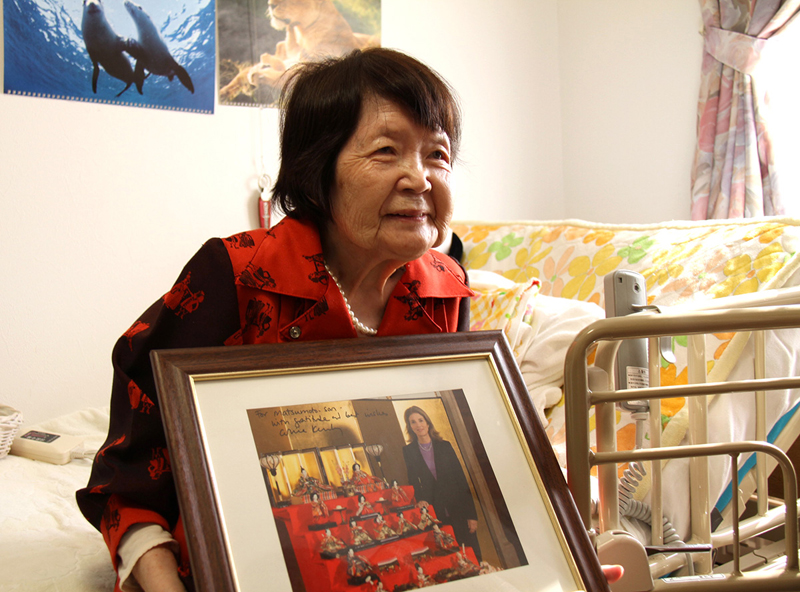When we send gifts out into the world, you never really know whose lives you’re going to touch and change. – U.S. Ambassador to Japan Caroline Kennedy
In 1962, the White House received a package from Japan containing a set of ornamental Japanese dolls from Ms. Tsuyako Matsumoto of Kitami, Hokkaido. Even though the Kennedy family did not know Ms. Matsumoto personally, the “Hina” dolls left a strong impression on Ambassador Kennedy as a young girl: “I always kept them in mind, and when I came back to Japan and I saw the dolls set up everywhere for this Girls’ Day holiday, I realized that I wanted to bring these dolls back to Japan and bring them home.”

Ms. Matsumoto’s generous gift played a role in forming Ambassador Kennedy’s positive image of Japan. Now, more than 50 years later, the dolls continue to embody the Japanese spirit of gift-giving, and demonstrate that extending a hand in friendship is one of the most important ways to build understanding between cultures and people.

In this October 1962 file photo provided by the White House, President John F. Kennedy, left, claps time as his children Caroline, center, and John, Jr. dance in the Oval Office. (©AP Images)
Hina dolls are elaborate Japanese dolls representing the Emperor, Empress, attendants, and musicians in the traditional court dress of the Heian period. Families display the dolls on platforms covered with red cloth in preparation for Girls’ Day on March 3 to wish for their daughters’ health and happiness.
Ambassador Kennedy recalls the dolls fondly: “When I was a little girl, many people from around the world sent me dolls from their home countries, and people who visited my father brought dolls for me. These were among the most special because they are so beautiful.” As U.S. Ambassador to Japan, she felt a strong urge to bring the dolls back home and display them at the Embassy as a symbol of the friendship between the United States and Japan.
The Kennedy Hina dolls have been carefully maintained over the years by the U.S. National Archives and were displayed in 2003 at the John F. Kennedy Museum as part of a special exhibit that showcased 75 dolls and puppets that the Kennedy family received from all around the world. When the Ambassador decided to display the dolls in Japan, she contacted the National Archives and asked them to ship them to Tokyo in preparation for Girls’ Day.
At the same time, she was determined to find the person who sent the dolls and thank her for sending such a gracious gift to her family. When the Ambassador visited Hokkaido in February 2015, she mentioned during a press interview that she was searching for Ms. Matsumoto, whose name and address were on record as the sender of the gift. Ambassador Kennedy was overjoyed when she learned that the mysterious sender of the Hina dolls had been located.
The Ambassador also discovered that Ms. Matsumoto had sent a number of letters and gifts to the White House, as well as to the U.S. Consulate in Sapporo and the U.S. Embassy in Japan, including lily of the valley bulbs that continue to thrive on the Embassy grounds today. When Ms. Matsumoto received a letter of appreciation from the White House, she was touched.
Ambassador Kennedy said she is delighted to be able to celebrate Girls’ Day in Japan while displaying these extraordinary Hina dolls which represent the deep ties between Japan and the United States and the shared hope for a bright future for girls everywhere.
“I think it’s wonderful to celebrate girls, and I think it’s wonderful for girls to feel special and to believe that they can do anything they want when they grow up,” Ambassador Kennedy said.







COMMENTS2
I very understanding your feeling.
It seens Hokado is your seccond home.
I The most respecting US president is your Dad JFK.
The best wishes you have good times in Japan Let us proude for ever.
i purchased a painting of President J.F.K. it was done just before his assassination . renown artist . and is dated .. it doesnt belong with us .. it is yours if you would like it . i can send pics if you wish …thx and GOD bless you
LEAVE A COMMENT
TOP